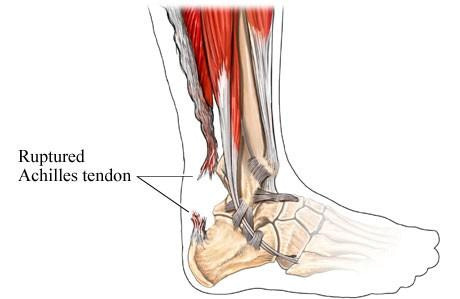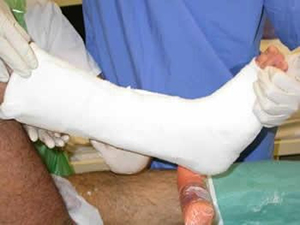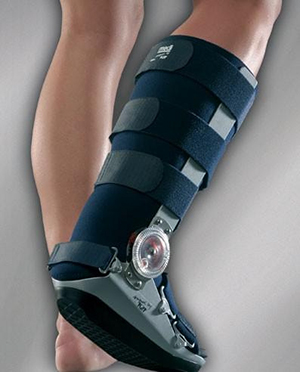 The Achilles tendon (or heel cord) is the thick strap that can be felt running down the back of the calf into the heel. When the Achilles tendon pulls on the heel it makes us go up on tiptoe, or pushes us forwards when walking or running. As we get older the tendon becomes less flexible and less able to absorb the repeated stresses of running. Eventually small “degenerative” tears develop in the fibres of the tendon. Sometimes the tendon becomes weakened by the degenerative process to the extent that it tears completely.
The Achilles tendon (or heel cord) is the thick strap that can be felt running down the back of the calf into the heel. When the Achilles tendon pulls on the heel it makes us go up on tiptoe, or pushes us forwards when walking or running. As we get older the tendon becomes less flexible and less able to absorb the repeated stresses of running. Eventually small “degenerative” tears develop in the fibres of the tendon. Sometimes the tendon becomes weakened by the degenerative process to the extent that it tears completely.
With a complete tear, you would probably feel a sudden pain in your heel or calf. Some people say this feels as though someone had kicked them on the calf, or hit them with a squash racquet. Usually the heel becomes painful, swollen and bruised, and it becomes difficult to walk.
The best treatment for a ruptured Achilles tendon is an operation to repair it in most circumstances. This leads to a stronger tendon and a lower re-rupture rate than if treated without an operation.
THE SURGERY
Three small cuts are made over the Achilles tendon. The ruptured ends of the tendon are found and strong sutures are used to stitch the tendon back together. The skin is closed, usually with a dissolving stitch buried under the skin. A plaster is applied to the leg.
Occasionally, there is some delay in making the diagnosis of a ruptured tendon. In this case, the tendon may be scarred in a shortened position. In this situation, a larger incision is used, and more extensive surgery is required, sometimes using another tendon to reinforce or replace the ruptured tendon.
|
FOLLOWING YOUR SURGERY
-
On the Ward
You cannot put any weight through your plaster in the first two weeks. You will be provided with crutches when you are discharged from hospital, and a physiotherapist will teach you how to use these.
-
When you go home
It is very important that the leg remains elevated most of the time in the first 2 weeks – rest is important. Do not wet or remove the dressings. It is normal to expect:
It is normal to expect:
-
SWELLING – This can be minimised by elevating your foot above your heart; icing the foot may be helpful
-
PAIN – You will receive a prescription for pain medication on discharge from hospital. Pain can also be minimised by elevating your leg.
-
BLEEDING – This always occurs. You may notice some oozing through the bandages.
Further Appointments
|
HOW SOON CAN I….
-
GO BACK TO WORK?
If your ankle is comfortable, you can work in a plaster and sit with your foot up most of the time (basically in a desk job), you could go back to work within a few weeks of surgery. On the other hand, if you do a heavy manual job you may need three or more months off work. How long you are off will depend on where your job fits between these two extremes.
-
DRIVE?
If you have your left foot operated on and have an automatic car you can drive within a few weeks of the operation, when your foot is comfortable enough. Otherwise you will have to wait until the ankle is strong and flexible enough to work the pedals, especially in an emergency situation. This will probably not be for 6-8 weeks after surgery.
When you return to driving you need to take it gradually at first and drive only short distances. Also remember that if you drive before you can stop or manoeuvre in an emergency your insurance will not cover you in the event of an accident.
-
PLAY SPORT?
You can gradually increase your level of activity under the guidance of your physiotherapist. Once you can walk comfortably you can start walking, swimming and cycling, increasing the distance covered gradually. As this recovers you can go back to low-impact, non-contact sports and finally to full contact sports. It is common to take 6-8 months to return to sports such as football or rugby.
IF YOU ARE CONCERNED:
|

 CAN IT BE DONE AS A DAY CASE OPERATION?
CAN IT BE DONE AS A DAY CASE OPERATION?
